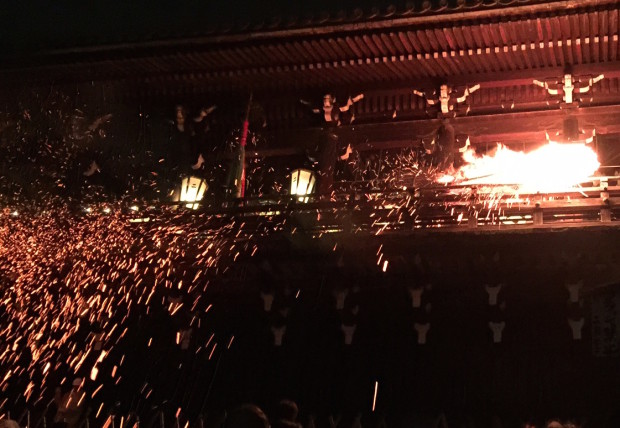お水取り(修二会)Omizutori ceremony

ニュースが東大寺のお水取りの始まりを写していた。丁度白髪先生の比叡山修行のところを読み返していたのでかビビッときてすぐさま行った。大門を潜っても二月堂への路は遠い。まるで一歩一歩と古代の時間に入っていくようだ。見上げれば松陰の間に三日月が空を切る。それは古径の線のように靭く。
灯が消され、二月堂は漆黒に包まれる。漆黒は人々の騒めきも飲み込んでしまう。やがて階段から小さな松明が密やかに、松明は次第に大きくなっていく、大きな松明がまるデーモンのように荒らしく駆け登っていく。次から次えと息をする間もなく。童子は回廊の大柱では高々と松明を振り回す、炎は風と戦うように勢いを増し火花を猛烈にドロッピングする。そして、炎のマッスは欄干を猛スピードで奔る。大柱で止められた炎は高々と持ち上げられ容赦なく人々の上に火花を撒き散らす。私は火の粉を被りながら、白髪先生のロープで製作している姿を呼び覚まされたのでした。
Just after I re-read Shiraga’s description of his training at the temple on Mount Hiei, I saw a newscast about the Omizutori (Shuni-e) ceremony beginning at Todaiji temple in Nara. Something clicked, so I rushed off to catch the ceremony. Arriving at Todaiji and entering the main gate, there was still a long way to walk. Each step I took seemed like a step back in time. Looking up, the crescent moon cut across the sky between the darkened pine trees, as supple as a line painted by Kokei Kobayashi.
With all the lights out, Nigatsu-do and its surroundings were pitch black, smothering the commotion of the people below. Then, the flames of small torches appeared quietly on the stairs. The torches grew larger, and a big torch rushed up the stairs as if it were a demon. One thing happened after another, without the chance to catch a breath. When the doji holding the torches arrive at the deck at the front of the hall, they lift their torches up high by the corner-post and wave them around, fanning the flames. The torches flare up vigorously, flames pitted against the rush of air, dropping a frenzy of sparks. Then the mass of flames rushes furiously along the balustrade until blocked by the post at the end, where the torch is lifted up again, remorselessly scattering sparks on the people below. Bathed in the shower of sparks, I recalled the figure of Shiraga painting, holding onto his rope.
